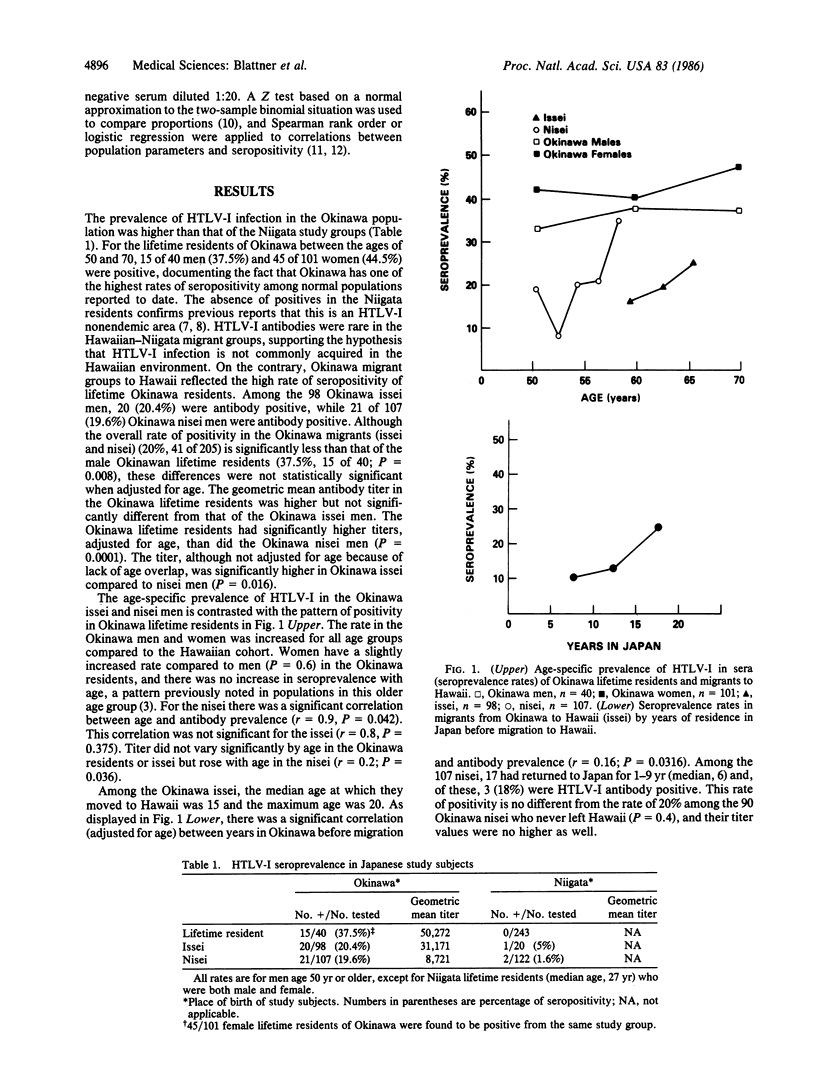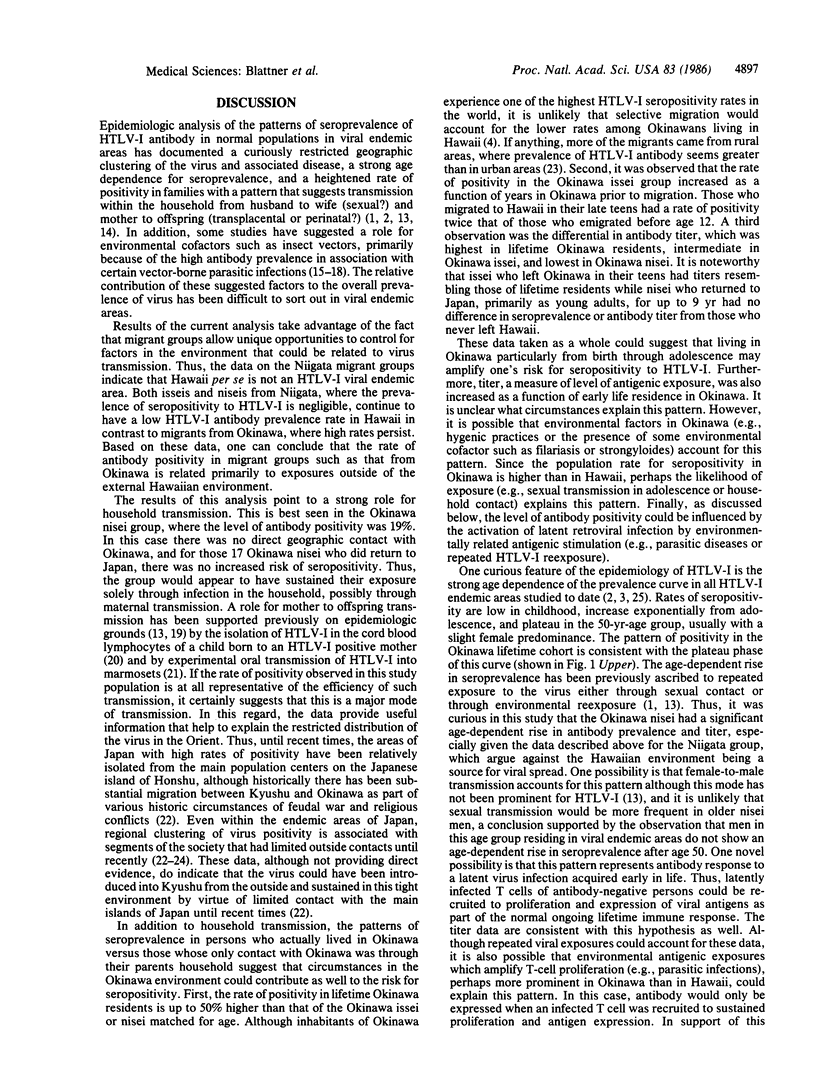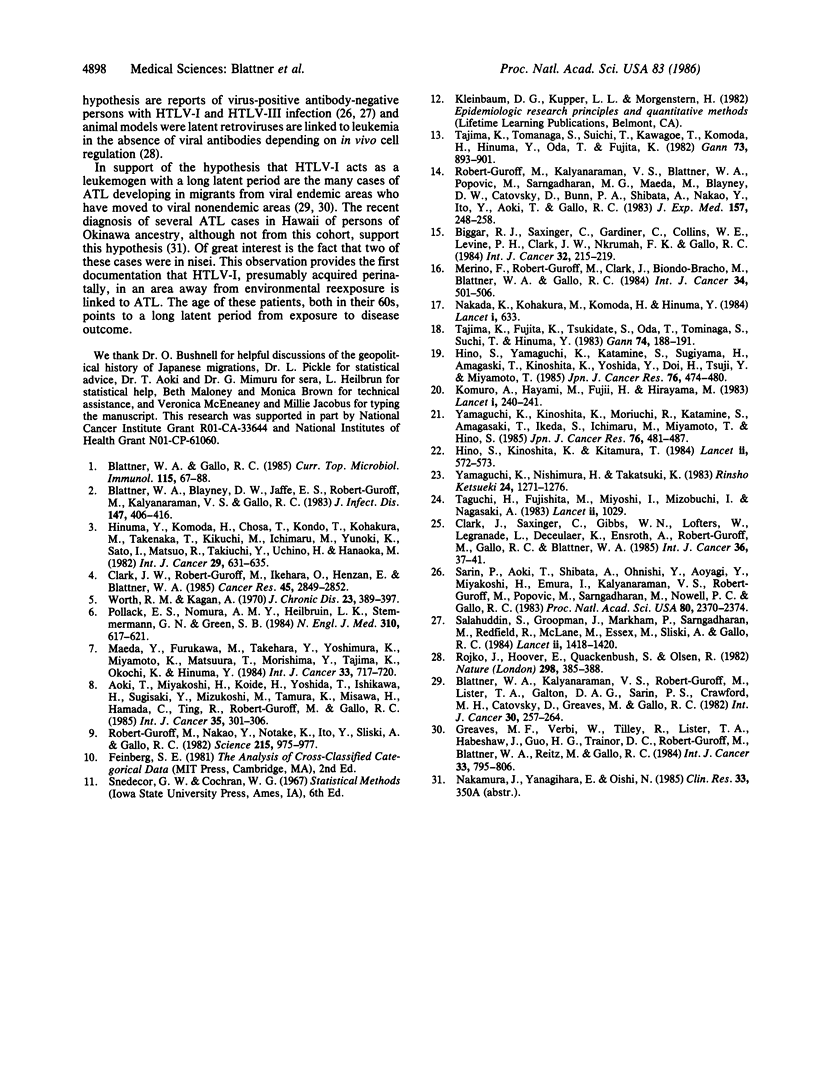Abstract
Human T-cell lymphotrophic virus type I (HTLV-I) seroprevalence was 20% among Hawaiian Japanese migrants (issei) and their offspring (nisei) from Okinawa compared to 35% in similarly aged men who were lifetime residents of Okinawa. A control group of migrants from a nonendemic area of Japan, Niigata, had low rates of HTLV-I antibodies, suggesting that Hawaii per se is not an endemic area for HTLV-I. Factors that were significantly associated with seropositivity in the Okinawa migrant groups were years of residence in Japan before migration (issei) and age for offspring of Okinawa migrants (nisei). Antibody titer was highest in Okinawa lifetime residents, intermediate in migrants (issei), and significantly lower in offspring of Okinawa migrants (nisei), with increasing titer observed with advancing age in the offspring of the migrant group. Based on these data, infection within the household occurring early in life appears to be a major route of HTLV-I transmission and may help to explain the curious geographic clustering of this virus in certain locales. As yet to be defined cofactors, including sexual transmission and/or environmental exposures (e.g., particularly before age 20), also may contribute to HTLV-I seropositivity. The pattern of rising seroprevalence and titer with age in the offspring of migrants who resided all of their lives in Hawaii raises the possibility that HTLV-I infection acquired early in life may become dormant and reexpressed with reactivation of latently infected T cells. The importance of this model in the process of viral leukemogenesis is supported by recent reports of adult T-cell leukemia in offspring (nisei) of Okinawa migrants.
Full text
PDF



Selected References
These references are in PubMed. This may not be the complete list of references from this article.
- Aoki T., Miyakoshi H., Koide H., Yoshida T., Ishikawa H., Sugisaki Y., Mizukoshi M., Tamura K., Misawa H., Hamada C. Seroepidemiology of human T-lymphotropic retrovirus type I (HTLV-I) in residents of Niigata Prefecture, Japan. Comparative studies by indirect immunofluorescence microscopy and enzyme-linked immunosorbent assay. Int J Cancer. 1985 Mar 15;35(3):301–306. doi: 10.1002/ijc.2910350304. [DOI] [PubMed] [Google Scholar]
- Biggar R. J., Saxinger C., Gardiner C., Collins W. E., Levine P. H., Clark J. W., Nkrumah F. K., Blattner W. A. Type-I HTLV antibody in urban and rural Ghana, West Africa. Int J Cancer. 1984 Aug 15;34(2):215–219. doi: 10.1002/ijc.2910340212. [DOI] [PubMed] [Google Scholar]
- Blattner W. A., Blayney D. W., Robert-Guroff M., Sarngadharan M. G., Kalyanaraman V. S., Sarin P. S., Jaffe E. S., Gallo R. C. Epidemiology of human T-cell leukemia/lymphoma virus. J Infect Dis. 1983 Mar;147(3):406–416. doi: 10.1093/infdis/147.3.406. [DOI] [PubMed] [Google Scholar]
- Blattner W. A., Gallo R. C. Human T-cell leukemia/lymphoma viruses: clinical and epidemiologic features. Curr Top Microbiol Immunol. 1985;115:67–88. doi: 10.1007/978-3-642-70113-9_5. [DOI] [PubMed] [Google Scholar]
- Blattner W. A., Kalyanaraman V. S., Robert-Guroff M., Lister T. A., Galton D. A., Sarin P. S., Crawford M. H., Catovsky D., Greaves M., Gallo R. C. The human type-C retrovirus, HTLV, in Blacks from the Caribbean region, and relationship to adult T-cell leukemia/lymphoma. Int J Cancer. 1982 Sep 15;30(3):257–264. doi: 10.1002/ijc.2910300302. [DOI] [PubMed] [Google Scholar]
- Clark J. W., Robert-Guroff M., Ikehara O., Henzan E., Blattner W. A. Human T-cell leukemia-lymphoma virus type 1 and adult T-cell leukemia-lymphoma in Okinawa. Cancer Res. 1985 Jun;45(6):2849–2852. [PubMed] [Google Scholar]
- Clark J., Saxinger C., Gibbs W. N., Lofters W., Lagranade L., Deceulaer K., Ensroth A., Robert-Guroff M., Gallo R. C., Blattner W. A. Seroepidemiologic studies of human T-cell leukemia/lymphoma virus type I in Jamaica. Int J Cancer. 1985 Jul 15;36(1):37–41. doi: 10.1002/ijc.2910360107. [DOI] [PubMed] [Google Scholar]
- Greaves M. F., Verbi W., Tilley R., Lister T. A., Habeshaw J., Guo H. G., Trainor C. D., Robert-Guroff M., Blattner W., Reitz M. Human T-cell leukemia virus (HTLV) in the United Kingdom. Int J Cancer. 1984 Jun 15;33(6):795–806. doi: 10.1002/ijc.2910330614. [DOI] [PubMed] [Google Scholar]
- Hino S., Kinoshita K., Kitamura T. HTLV and the propagation of Christianity in Nagasaki. Lancet. 1984 Sep 8;2(8402):572–573. doi: 10.1016/s0140-6736(84)90780-3. [DOI] [PubMed] [Google Scholar]
- Hino S., Yamaguchi K., Katamine S., Sugiyama H., Amagasaki T., Kinoshita K., Yoshida Y., Doi H., Tsuji Y., Miyamoto T. Mother-to-child transmission of human T-cell leukemia virus type-I. Jpn J Cancer Res. 1985 Jun;76(6):474–480. [PubMed] [Google Scholar]
- Hinuma Y., Komoda H., Chosa T., Kondo T., Kohakura M., Takenaka T., Kikuchi M., Ichimaru M., Yunoki K., Sato I. Antibodies to adult T-cell leukemia-virus-associated antigen (ATLA) in sera from patients with ATL and controls in Japan: a nation-wide sero-epidemiologic study. Int J Cancer. 1982 Jun 15;29(6):631–635. doi: 10.1002/ijc.2910290606. [DOI] [PubMed] [Google Scholar]
- Komuro A., Hayami M., Fujii H., Miyahara S., Hirayama M. Vertical transmission of adult T-cell leukaemia virus. Lancet. 1983 Jan 29;1(8318):240–240. doi: 10.1016/s0140-6736(83)92613-2. [DOI] [PubMed] [Google Scholar]
- Maeda Y., Furukawa M., Takehara Y., Yoshimura K., Miyamoto K., Matsuura T., Morishima Y., Tajima K., Okochi K., Hinuma Y. Prevalence of possible adult T-cell leukemia virus-carriers among volunteer blood donors in Japan: a nation-wide study. Int J Cancer. 1984 Jun 15;33(6):717–720. doi: 10.1002/ijc.2910330602. [DOI] [PubMed] [Google Scholar]
- Merino F., Robert-Guroff M., Clark J., Biondo-Bracho M., Blattner W. A., Gallo R. C. Natural antibodies to human T-cell leukemia/lymphoma virus in healthy Venezuelan populations. Int J Cancer. 1984 Oct 15;34(4):501–506. doi: 10.1002/ijc.2910340412. [DOI] [PubMed] [Google Scholar]
- Nakada K., Kohakura M., Komoda H., Hinuma Y. High incidence of HTLV antibody in carriers of Strongyloides stercoralis. Lancet. 1984 Mar 17;1(8377):633–633. doi: 10.1016/s0140-6736(84)91030-4. [DOI] [PubMed] [Google Scholar]
- Pollack E. S., Nomura A. M., Heilbrun L. K., Stemmermann G. N., Green S. B. Prospective study of alcohol consumption and cancer. N Engl J Med. 1984 Mar 8;310(10):617–621. doi: 10.1056/NEJM198403083101003. [DOI] [PubMed] [Google Scholar]
- Robert-Guroff M., Kalyanaraman V. S., Blattner W. A., Popovic M., Sarngadharan M. G., Maeda M., Blayney D., Catovsky D., Bunn P. A., Shibata A. Evidence for human T cell lymphoma-leukemia virus infection of family members of human T cell lymphoma-leukemia virus positive T cell leukemia-lymphoma patients. J Exp Med. 1983 Jan 1;157(1):248–258. doi: 10.1084/jem.157.1.248. [DOI] [PMC free article] [PubMed] [Google Scholar]
- Robert-Guroff M., Nakao Y., Notake K., Ito Y., Sliski A., Gallo R. C. Natural antibodies to human retrovirus HTLV in a cluster of Japanese patients with adult T cell leukemia. Science. 1982 Feb 19;215(4535):975–978. doi: 10.1126/science.6760397. [DOI] [PubMed] [Google Scholar]
- Rojko J. L., Hoover E. A., Quackenbush S. L., Olsen R. G. Reactivation of latent feline leukaemia virus infection. Nature. 1982 Jul 22;298(5872):385–388. doi: 10.1038/298385a0. [DOI] [PubMed] [Google Scholar]
- Salahuddin S. Z., Groopman J. E., Markham P. D., Sarngadharan M. G., Redfield R. R., McLane M. F., Essex M., Sliski A., Gallo R. C. HTLV-III in symptom-free seronegative persons. Lancet. 1984 Dec 22;2(8417-8418):1418–1420. doi: 10.1016/s0140-6736(84)91619-2. [DOI] [PubMed] [Google Scholar]
- Sarin P. S., Aoki T., Shibata A., Ohnishi Y., Aoyagi Y., Miyakoshi H., Emura I., Kalyanaraman V. S., Robert-Guroff M., Popovic M. High incidence of human type-C retrovirus (HTLV) in family members of a HTLV-positive Japanese T-cell leukemia patient. Proc Natl Acad Sci U S A. 1983 Apr;80(8):2370–2374. doi: 10.1073/pnas.80.8.2370. [DOI] [PMC free article] [PubMed] [Google Scholar]
- Taguchi H., Fujishita M., Miyoshi I., Mizobuchi I., Nagasaki A. HTLV antibody positivity and incidence of adult T-cell leukaemia in Kochi prefecture, Japan. Lancet. 1983 Oct 29;2(8357):1029–1029. doi: 10.1016/s0140-6736(83)91015-2. [DOI] [PubMed] [Google Scholar]
- Tajima K., Fujita K., Tsukidate S., Oda T., Tominaga S., Suchi T., Hinuma Y. Seroepidemiological studies on the effects of filarial parasites on infestation of adult T-cell leukemia virus in the Goto Islands, Japan. Gan. 1983 Apr;74(2):188–191. [PubMed] [Google Scholar]
- Tajima K., Tominaga S., Suchi T., Kawagoe T., Komoda H., Hinuma Y., Oda T., Fujita K. Epidemiological analysis of the distribution of antibody to adult T-cell leukemia-virus-associated antigen: possible horizontal transmission of adult T-cell leukemia virus. Gan. 1982 Dec;73(6):893–901. [PubMed] [Google Scholar]
- Worth R. M., Kagan A. Ascertainment of men of Japanese ancestry in Hawaii through World War II Selective Service registration. J Chronic Dis. 1970 Nov;23(5):389–397. doi: 10.1016/0021-9681(70)90022-6. [DOI] [PubMed] [Google Scholar]
- Yamaguchi K., Nishimura H., Takatsuki K. [Clinical features of malignant lymphoma and adult T-cell leukemia in Kumamoto]. Rinsho Ketsueki. 1983 Sep;24(9):1271–1276. [PubMed] [Google Scholar]
- Yamanouchi K., Kinoshita K., Moriuchi R., Katamine S., Amagasaki T., Ikeda S., Ichimaru M., Miyamoto T., Hino S. Oral transmission of human T-cell leukemia virus type-I into a common marmoset (Callithrix jacchus) as an experimental model for milk-borne transmission. Jpn J Cancer Res. 1985 Jun;76(6):481–487. [PubMed] [Google Scholar]


